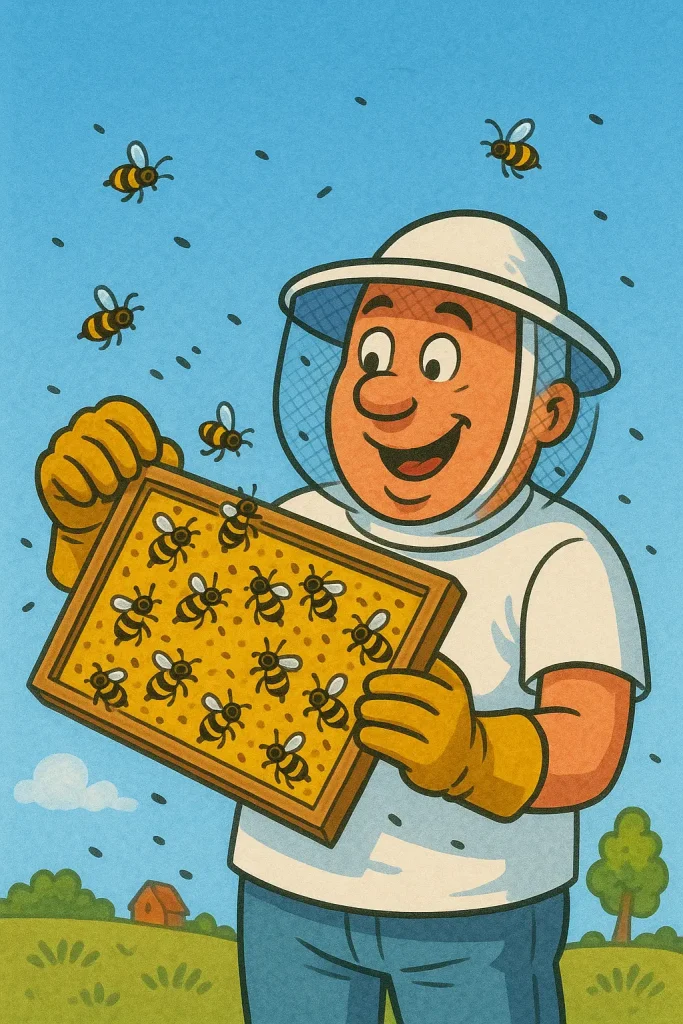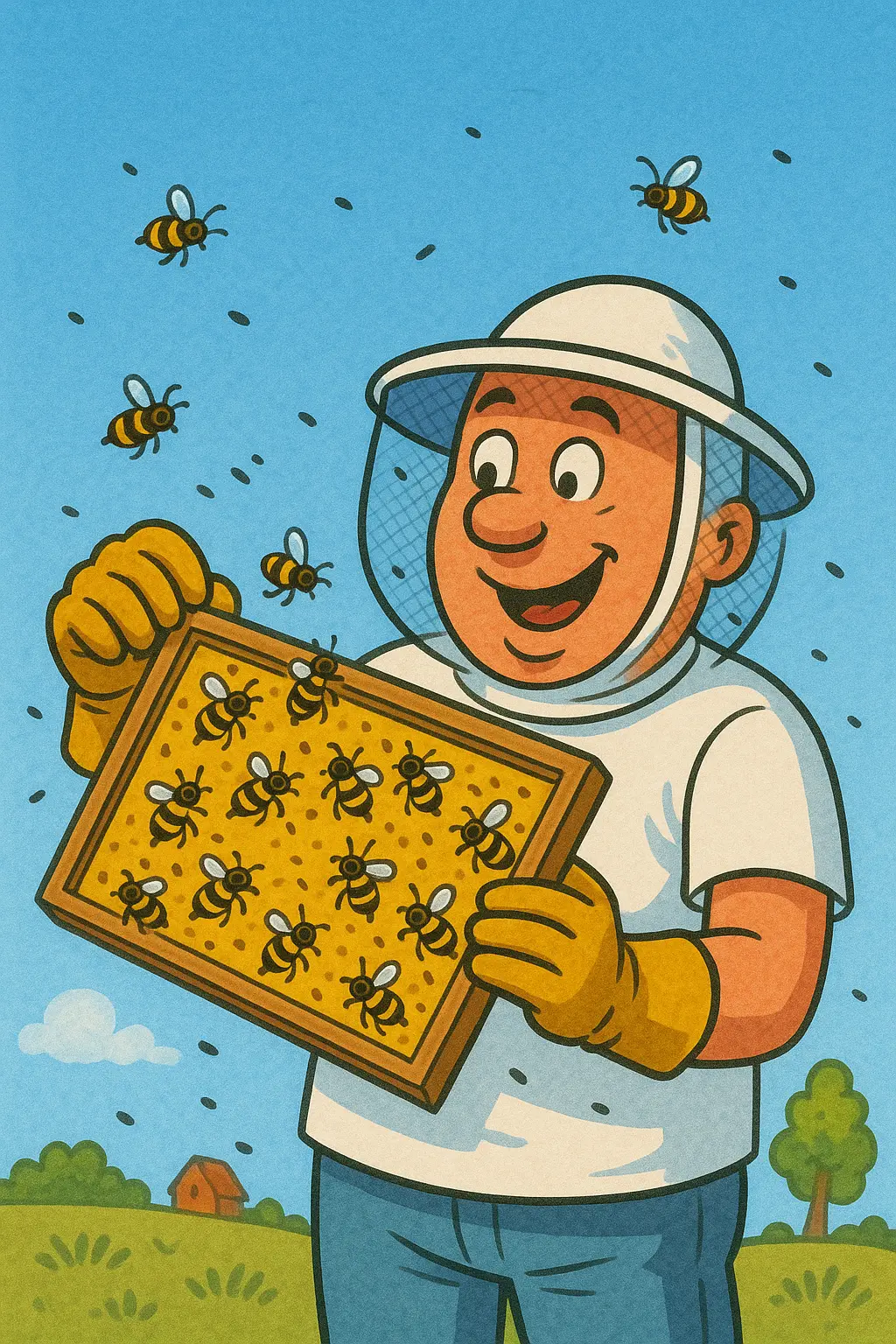Successful beekeeping depends on two things: knowing when to open a hive and knowing what to do once it’s open. Many books describe hive inspections but often stop short of pinpointing the triggers for action. This guide organises practical beekeeping experience into a clear system that helps colonies stay healthy, productive, and easy to manage.
When Should You Inspect a Hive?

The common advice is to wait for 15°C and sunny, “shirt-sleeve” weather. But real-world conditions are more nuanced:
- Sunshine adds warmth. 15°C in the shade may feel like 20°C in the sun.
- Wind subtracts warmth. Even a mild breeze can cool the colony quickly.
- Quick checks are possible in cooler weather. Experienced beekeepers sometimes inspect briefly at 10°C if urgent.
- Moisture matters. Light drizzle can be tolerated for quick checks, but heavy rain should always stop inspections.
Rule of thumb: open colonies only when there’s a purpose, and keep the disruption as brief as conditions demand.
The Seven Questions Every Inspection Should Answer
Ted Hooper’s classic five inspection questions can be stretched into a seven-step checklist that matches the natural flow of opening a hive:
- Are there enough food stores?
- Does the colony have enough super space?
- Are eggs present?
- Are queen cells present?
- Does the queen have enough brood space?
- Is the colony developing as expected?
- Are there any signs of disease or poor temper?
Food Stores and the “June Gap”
Colonies need at least one to two frames of honey per week to thrive – strong colonies may require more. Always check the weight of supers when removing them.
Tips:
- Leave at least half a super of honey in June. This helps colonies through the unpredictable “June gap,” when nectar can dry up for several weeks.
- Don’t be greedy with honey harvests. Leaving extra stores often results in higher yields later in the year.
Supering: Why Early Space Matters
The traditional rule of adding a super when the last one is half full is often too late. Without enough space, bees backfill the brood nest, crowd the queen, and trigger swarming.
Best practice:
- Add supers as soon as bees move into the top one, ideally two at a time in spring.
- Remember: nectar can contain over 70% water, so processing requires enormous space for evaporation.
- Drone comb is preferable to foundation, as bees can use it immediately. Foundation slows them down.
Eggs and Test Frames
Eggs are the single most important indicator of colony health. If no eggs are visible:
- Insert a test frame with eggs and young larvae from another colony.
- Mark the frame with the date for reference.
- Recheck in 7 – 14 days. If bees ignore the frame twice, the colony likely has an unseen queen and won’t accept a replacement.
Tip: Don’t waste money on buying queens for eggless colonies. Buy a nuc instead – you gain a queen, plus extra bees and brood for test frames.
Queen Cells and Swarm Control
Queen cells can mean swarming, supersedure, or emergency response. Location is a clue, but not a guarantee.
- If multiple cells are present: treat as swarm preparation.
- Always reduce to one queen cell. Giving bees “choices” often leads to swarms.
- Check again after a week. If you miss eggs or larvae, bees will produce more queen cells.
Managing Brood Space and Colony Growth
Brood space and colony expansion are closely linked:
- Colonies should roughly double every three weeks in spring.
- If brood boxes reach 9 – 10 frames, remove sealed brood and replace with drawn comb to give the queen more space.
- Weak colonies stuck at one or two frames rarely recover – combine them with stronger hives.
Disease and Pest Awareness
Not all poor brood patterns mean foulbrood. Often, queen failure is the root issue. Still, distinguish between:
- Bacterial disease (foulbrood): notifiable, requires immediate reporting.
- Viral diseases (e.g., sacbrood, CBPV): often seasonal or stress-related.
- Fungal issues (chalkbrood, nosema): preventable with good hygiene and acetic acid treatment of stored frames.
Control varroa consistently – deformed wing virus is its direct by-product.
Assessing Temper
Colony temperament matters as much as productivity. Use the Jo Widdicombe simple -2 to +2 scale:
- -2 (Stingy): Bees sting aggressively through clothing.
- -1 (Pingy): Bees bounce off veil and suit.
- 0 (Buzzy): Bees fly around but make no contact.
- +1 (Flighty): Bees take to the air but ignore the beekeeper.
- +2 (Calm): Bees remain on the comb, unbothered.
Action: Aggressive colonies are best requeened using eggs from calm stock, not by introducing bought queens.
Strengthening Colonies with Nucs
Nucleus colonies are a beekeeper’s safety net. Use them to:
- Reinforce weak colonies with fresh bees and brood.
- Replace failing queens with young, tested ones.
- Provide insurance against unpredictable losses.
Combined correctly, nucs can turn failing colonies into honey producers within weeks.
Record Keeping: Keep It Simple
Don’t overcomplicate records. Focus on essentials:
- Eggs present or not
- Available space
- Presence of queen cells or disease
- Temper
With experience, records can be pared down further. The key is to leave every colony in good order before leaving the apiary.
Final Thoughts
The essence of good inspections is knowing the difference between when to act and when to wait.
- Open colonies only with purpose.
- Act on triggers like lack of eggs, queen cells, or overcrowding.
- Prepare nucs in advance to reinforce or replace failing colonies.
- Always propagate from calm, productive hives.
With these practices, inspections become less about routine disruption and more about timely, effective interventions that lead to healthier bees and bigger honey harvests.
